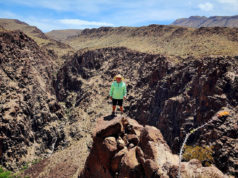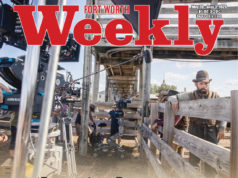 That’s what some residents just south of downtown Fort Worth decided to do, when they realized that Four Sevens Resources wants to put eight gas wells in a half-mile stretch along 8th Avenue — near the railroad tracks just across the street from the expensively restored gateway to historic Ryan Place and nearby Fairmount neighborhoods and even closer to Mistletoe Heights and Berkeley neighborhoods. Attorney Liane Janovsky is trying to convince residents to refuse to lease their mineral rights; if enough of them agree, it could prevent the company from drilling. That, in turn, may explain a new level of intensity on the part of landmen working in those parts of town, trying to get people to sign the leases before Janovsky or someone else convinces them otherwise.
That’s what some residents just south of downtown Fort Worth decided to do, when they realized that Four Sevens Resources wants to put eight gas wells in a half-mile stretch along 8th Avenue — near the railroad tracks just across the street from the expensively restored gateway to historic Ryan Place and nearby Fairmount neighborhoods and even closer to Mistletoe Heights and Berkeley neighborhoods. Attorney Liane Janovsky is trying to convince residents to refuse to lease their mineral rights; if enough of them agree, it could prevent the company from drilling. That, in turn, may explain a new level of intensity on the part of landmen working in those parts of town, trying to get people to sign the leases before Janovsky or someone else convinces them otherwise.
Kendall McCook lives on the South Side. When he first heard of the plan by the Four Sevens company to put gas wells in his neighborhood, he said, “I thought ‘Four 7s — my lucky day.’” But when he found out the company was planning to drill the wells on nearby 8th Avenue, McCook decided he wanted no part of it. (In fact, it now appears that the well across from Ryan Place’s columned entrance would be only about half as far away from buildings as the 600-foot minimum required by Fort Worth ordinance, and so would require a variance.) “Well, then I began to get calls from Four Sevens asking if I’d signed the lease,” McCook said. “And I made it clear that I hadn’t and wouldn’t. I lived near Comanche Peak [nuclear power project, near Glen Rose] when they were putting the reactor in, and living near something where you constantly think of what might go wrong just drives you crazy.” When he continued to say no over the phone, two gas company reps showed up at his house. When he still wouldn’t sign, McCook said, “the man sort of got in my face and told me I might as well, because they were going to drill whether I signed or not. So I told him to get the hell off my property. Which he did, but only after we had a short philosophical conversation, shall we say.”
Both Colt Exploration — acting as landmen on the 8th Avenue project — and Four Sevens denied that their workers harass or intimidate anyone. But McCook’s is not the only report of such tactics. According to Janovsky, a member of the Ryan Place Improvement Association’s gas committee, “Some Fairmount residents canvassed by Colt report that they are being subjected to high-pressure sales tactics and overt hostility when they decline to sign the leases.” And anti-gas well activist Don Young said that when — by Janovsky’s invitation — he showed up at a March 13 Southside meet-and-greet with representatives of Four Sevens and Colt and started passing out fliers, “this big fellow, must have been six-foot-five, walked over and leaned over me and said he was going to have to ask me to leave.” When Young refused, he said, the big guy and several of his colleagues “began harassing me, laughing, yelling at me, making snide comments, trying to intimidate me.”
The idea that residents of the Southside neighborhoods might block drilling there explains in part why some landmen are resorting to tough tactics. But consider this: If Four Sevens can get the right to drill in the 8th Avenue corridor, the gas company can tap into an existing gas pipeline under the avenue and save millions in costs of building a connection from its wells to the transport line. Didn’t know there was a gas pipeline there? Most people wouldn’t. Buried pipelines carrying natural gas, propane, sewage, water, and electrical wiring are a fact of life in big cities and across the countryside. But the fact is that the Barnett Shale boom means more and more of those pipelines are being built in highly urban areas. It’s a situation that is starting to make local safety officials, fire departments, and paramedics sweat — particularly in Texas, where nobody is required to let them know where such pipelines are buried. In fact, no one but the company, the Railroad Commission, and the property owners know even roughly where the pipelines are.
Pipelines aren’t the only dangerous aspect of the gas boom that seems to be on the increase. Even gas company officials admit that the boom is drawing more and more inexperienced workers to drilling sites. “Veteran crews are being divided up and filled with people who have no experience whatsoever working rigs, laying pipe, and such,” said pipeline company manager Jerry Holsworth. And so accidents are increasing. At least two people have been killed in Barnett Shale operations thus far — not including the teenager who climbed atop a gas storage tank and lit a match to look into it over on the Wise-Parker county line last December — and there have been several accidents that caused injuries and evacuations. Up until now, most of those accidents have happened in rural or semi-rural areas, but these days they could just as easily happen in a heavily populated city neighborhood.
The Fort Worth Fire Department and other emergency workers refused to speculate on just how devastating such an accident could be — “I can’t play the ‘what if’ thing. I just can’t go there,” explained one local emergency services official. But Gary Hogan, who got an education in gas well issues as a member of Fort Worth’s gas drilling task force, said that if the recent Parker County explosion had happened in Fort Worth, “you’d be looking, minimally, at total incineration for hundreds of feet in all directions from the explosion point.” Then there’s the question of the money people think they’ll be getting every month. Truth is, by the time the royalties are divvied up among all the people who own part of the 80 acres or so atop a gas well, they’ll be lucky if the check covers dinner out once a month — and we’re not talking steak. Dave Stovall, owner of Old Town Real Estate Services on Park Place in the heart of the historic neighborhoods, said that if there is an inner-city accident related to a gas well or pipeline, insurance rates for homes near gas wells are going to go up, probably canceling out those royalty payments.
When landmen came calling in rural Parker and Johnson counties a few years ago to ask if they might lease mineral rights, it was often a no-brainer. They offered $500 per acre in bonus money and a share in 20 percent of any income produced by any wells they drilled beneath your property. For someone with 10 acres, it was a pretty good bonus, plus royalties that might run $1,000 or even as high as $3,000 a month. There was the inconvenience of the water-truck traffic, of course, some ruined road surfaces, even the chance of a gas leak or explosion, but probably not right next to your house, and nothing that that kind of money couldn’t make you overlook — even after taxes and the costs of moving the gas from the well-head to the sale point were deducted from the checks. But much of that land in the rural areas of the Barnett Shale has been snapped up, and the landmen and the wells are moving closer and closer to downtown Fort Worth. Offers have gone up as the play becomes more difficult: These days the landmen are offering $500 per residential lot as a bonus and a share in 25 percent of the royalties. For those worrying about next month’s mortgage or rent, it’s still a no-brainer: $500 is $500, after all. And then there are going to be those monthly checks coming in, which the landmen tell you might run anywhere from $50 to $300 a month. Just sign on the dotted line.
 Unfortunately, there probably won’t be any $300 monthly checks and very few $50 checks, at least in Fort Worth proper. That’s because most residents here don’t own 10 acres or even one. They own maybe a sixth, or even a fifteenth of an acre, which means that, for a normal well, anywhere from 480 to 1,200 of your neighbors may be sharing those royalties. If it’s a really productive well, and the homeowner royalties total $25,000 per month, then somebody with a large lot gets a not-so-royal $52 a month. Those with small lots might get $20. And both amounts are before taxes and fees are subtracted. For a run-of-the mill well, cut those numbers in half. For an absolute gusher, the best well in the whole Barnett Shale, you might get five times that for the first few months, before the production levels off. For the landmen getting commissions on each signed lease, there’s still plenty of money to be made. And the gas companies will reap a fortune despite their up-front costs, because they’re looking at decades of production. The modest size of those checks hasn’t stopped most homeowners from signing on as yet, but in some communities, residents are questioning whether the payoff is worth the price. So in some areas, the landsmen are sweetening the pot. In Berkeley, for instance, Colt Explorations recently offered to pitch in $25,000 to help restore a local park if enough homeowners sign up. And if residents hold out, that figure will probably go up.
Unfortunately, there probably won’t be any $300 monthly checks and very few $50 checks, at least in Fort Worth proper. That’s because most residents here don’t own 10 acres or even one. They own maybe a sixth, or even a fifteenth of an acre, which means that, for a normal well, anywhere from 480 to 1,200 of your neighbors may be sharing those royalties. If it’s a really productive well, and the homeowner royalties total $25,000 per month, then somebody with a large lot gets a not-so-royal $52 a month. Those with small lots might get $20. And both amounts are before taxes and fees are subtracted. For a run-of-the mill well, cut those numbers in half. For an absolute gusher, the best well in the whole Barnett Shale, you might get five times that for the first few months, before the production levels off. For the landmen getting commissions on each signed lease, there’s still plenty of money to be made. And the gas companies will reap a fortune despite their up-front costs, because they’re looking at decades of production. The modest size of those checks hasn’t stopped most homeowners from signing on as yet, but in some communities, residents are questioning whether the payoff is worth the price. So in some areas, the landsmen are sweetening the pot. In Berkeley, for instance, Colt Explorations recently offered to pitch in $25,000 to help restore a local park if enough homeowners sign up. And if residents hold out, that figure will probably go up.
“There are so many issues involved in this,” said Janovsky. “There are four neighborhoods here — Ryan Place, Mistletoe Heights, Berkeley, and Fairmount — and two of them are National Historic Districts. And the gas companies want to put eight wells … between Elizabeth Boulevard and Park Place. That will just be devastating for all of us.” Janovsky cites the increased traffic, noise pollution, roads being ruined, home devaluation, and, scariest of all, the possibility of explosions if train sparks come in contact with leaking gas — all the standard reasons for not wanting a well in your back yard. And while, until recently, residents of Mistletoe Heights and Berkeley have been banding together to try to maximize their royalty percentages, Janovsky is trying to stop the wells altogether. “I’m coming from the point of view of ‘if we don’t sign, they can’t drill,’” she said. That will be an uphill battle in a town that’s gas crazy. Despite assurances from the gas companies that they take every precaution to avoid them, accidents are occurring frequently enough in the Barnett Shale to make a lot of people uneasy.
In April 2005, Tab Dotson was working for a crew in Wise County drilling a new well next to an existing well, both owned by EnCana Corp., a Canadian oil and gas firm with deep roots in the Barnett Shale. He was killed when the forklift he was driving knocked open the supposedly dead well and it exploded. His family is suing EnCana for allegedly providing inaccurate information about the well. EnCana spokesman Alan Boras told the Weekly that he couldn’t comment because of the lawsuit. Later that year, an explosion at a Palo Pinto well site blew rocks the size of pickup trucks into the air and left a crater half the size of a football field. In April 2006, Robert Gayan was killed when a gas well he was working on in Forest Hill exploded, and hundreds of families had to be evacuated. Five months later, fire broke out at a gas well just south of Azle, forcing teachers to herd students at nearby Silver Creek Elementary School into the school’s main building to avoid the thick smoke. The following month, a pipeline ruptured in Wise County, leaving a 30-foot-wide hole in the ground.
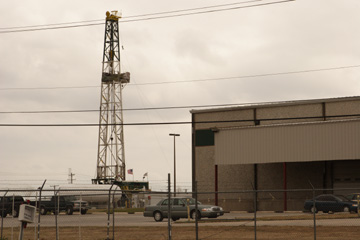 In February of this year, a minor gas well explosion occurred near the little town of Lillian in Johnson County, when a pocket of gas “burped” from a well that was being drilled, forcing the evacuation of several nearby families. And just a few weeks ago, a major fire broke out near Weatherford when a backhoe digging a trench for a new Barnett Shale pipeline hit existing propane and gas lines, destroying a number of vehicles and melting a high-voltage power line that left 5,000 people without electricity for several hours. Gas company officials play up their safety records, and tend to explain away each incident. But even some of them admit to some worries. “There are so many rigs going up that inexperienced people are being recruited to work the gas boom,” said Deborah West, a spokeswoman for EnCana. She emphasized that drilling rig crews don’t usually work directly for EnCana, but then added that “they’re part of our family when we’re working together.” EnCana frequently has one of their own men working alongside the contracted drilling crews to make certain that safety regulations and precautions are adhered to, West said.
In February of this year, a minor gas well explosion occurred near the little town of Lillian in Johnson County, when a pocket of gas “burped” from a well that was being drilled, forcing the evacuation of several nearby families. And just a few weeks ago, a major fire broke out near Weatherford when a backhoe digging a trench for a new Barnett Shale pipeline hit existing propane and gas lines, destroying a number of vehicles and melting a high-voltage power line that left 5,000 people without electricity for several hours. Gas company officials play up their safety records, and tend to explain away each incident. But even some of them admit to some worries. “There are so many rigs going up that inexperienced people are being recruited to work the gas boom,” said Deborah West, a spokeswoman for EnCana. She emphasized that drilling rig crews don’t usually work directly for EnCana, but then added that “they’re part of our family when we’re working together.” EnCana frequently has one of their own men working alongside the contracted drilling crews to make certain that safety regulations and precautions are adhered to, West said.
Holsworth, manager of Midstream Operations, a division of Devon Energy Corp., a major Barnett Shale player, admitted that having so many wells going up is a cause of concern. “What we’re seeing is that with all this drilling, veteran crews are being divided and filled up with people who have no experience whatsoever working rigs, laying pipe, and such,” he said. “But we have a program where we go out and look at the workers, and if we see someone doing something wrong, we have a contracted safety inspector there to teach them how to do it right.” Journeymen crew members at well sites around Johnson and Tarrant County told the Weekly that they are careful because their own safety as well as the company’s money and reputation is at stake. But they didn’t suggest that the work is danger-free, for themselves or others. “I want to go home to my family,” said a foreman working on a rig in Lillian. “If I cut a corner or let some new guy make a mistake, maybe none of us go home. Or if we do, maybe we’re burned or crippled.” Still with the demand for able bodies — Devon alone has more than 2,700 producing wells in the Barnett Shale and is planning on drilling 385 more by the end of this year — Holsworth said, “the new kids are definitely a concern. But hopefully having our safety inspector contractors out on site, and with daily safety briefings, we’re having an impact. Our contractor incident rate” — jargon for accident rate — “is dropping, so we think so.”
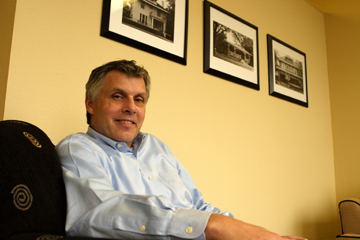 According to Holsworth, the biggest dangers don’t come from the actual drilling or even pipeline work, but from people who have nothing to do with the gas industry. “What we see is that when these rural farms that have wells on them get divided up into house or trailer lots, a lot of people put trailers right on top of our pipelines. Now that is where there is enormous danger. Or when someone suddenly decides to put in a swimming pool by themselves, or dig a pond.” Things can go wrong in a hurry in those cases, he said. He said that, although there is no requirement that pipelines be marked, Midstream always marks them anyway. “Of course a farmer might take those markers out, and there is nothing we can do about that. But if we see someone putting a trailer or septic tank in a field that has our pipes, we not only let them know it, we offer to help them move their trailer.” Holsworth is right that Texas has few requirements for companies to tell others where the lines are buried. The Railroad Commission and the landowner get copies of documents showing where the easement runs — but not necessarily where within that 15- to 50-foot strip the pipe is actually located. And that’s it — neither local fire departments nor anyone else is told where the lines are. They may run under your house buried just inches under the surface; older lines may still be above the ground. These days, Devon puts theirs at least 42 inches deep to avoid backhoe accidents, but not everyone does that.
According to Holsworth, the biggest dangers don’t come from the actual drilling or even pipeline work, but from people who have nothing to do with the gas industry. “What we see is that when these rural farms that have wells on them get divided up into house or trailer lots, a lot of people put trailers right on top of our pipelines. Now that is where there is enormous danger. Or when someone suddenly decides to put in a swimming pool by themselves, or dig a pond.” Things can go wrong in a hurry in those cases, he said. He said that, although there is no requirement that pipelines be marked, Midstream always marks them anyway. “Of course a farmer might take those markers out, and there is nothing we can do about that. But if we see someone putting a trailer or septic tank in a field that has our pipes, we not only let them know it, we offer to help them move their trailer.” Holsworth is right that Texas has few requirements for companies to tell others where the lines are buried. The Railroad Commission and the landowner get copies of documents showing where the easement runs — but not necessarily where within that 15- to 50-foot strip the pipe is actually located. And that’s it — neither local fire departments nor anyone else is told where the lines are. They may run under your house buried just inches under the surface; older lines may still be above the ground. These days, Devon puts theirs at least 42 inches deep to avoid backhoe accidents, but not everyone does that.
Workers — including homeowners — planning to dig 18 inches or deeper are supposed to call what’s known as the Texas One Call system 48 hours before they stick a blade in the ground. One Call employees contact everyone who has underground lines in the area, and those outfits are supposed to let the diggers know where the lines are. Holsworth said Midstream Operations will actually send someone out to those sites “to make sure we don’t have a line where they’re planning on digging.” Of course not every homeowner knows about the system, and One Call doesn’t really know about every line ever put down under Texas soil. Thousands of miles of gas, oil, and propane lines laid decades ago and since abandoned could still be accidents waiting to happen. But, as in Weatherford, knowing generally where a line is supposed to be located doesn’t mean a backhoe operator is never going to make a mistake — or act on bad information. In rural Parker County, the result was some torched trucks and a plume of fire visible 30 miles away in Fort Worth. In the city, it could mean a neighborhood going up in flames.
Holsworth said Devon runs a big ad once a year in the Fort Worth Star-Telegram to remind people about the One Call system, and also sends people to teach local firefighters how to locate gas lines and deal with gas line accidents. Randy Renois is the Tarrant County executive fire marshal. “Not knowing where lines are running could be a problem if there were any sort of accident,” he said, because his men wouldn’t necessarily know in what direction a fire might be headed — and whether they were moving toward or away from danger. A few companies, he said, provide pipeline location information, but there is no county requirement that they do so. In Fort Worth, said John Garfield, assistant director for development, “We have no regulations on gas pipes,” but they’re looking into it. He said the city is considering requiring companies to “provide us with digital survey information of exactly where their feeder lines are — the lines that run from the wellheads to the interstate transport pipes — but we haven’t done that yet.” When a new subdivision is developed in the city, he said, locations of all lines are noted on the plat maps. “But if a well is put near an existing group of homes or apartment complex, there would be no replat. So what I’m saying is that the first responders would not get information as to where those lines are.”
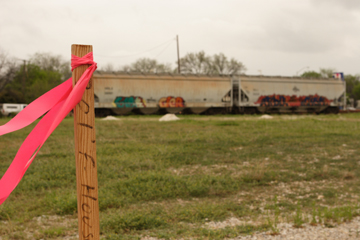 Getting companies to deliver pipeline maps to local officials might not be that tough, Garfield said, “if someone would take the bull by the horns on that issue.” Railroad Commission spokeswoman Ramona Nai didn’t seem to see the issue as particularly pressing. “If you have natural gas heating your home, you already have a pipeline running right to your house,” she said — though the difference in danger between a residential line less than an inch in diameter and a 6”- to 8”-diameter pipeline is a big one. “I’m not going to speculate on potential problems that could occur” from pipelines, she said. “The Railroad Commission has no official stance on that issue.” Don Young, who’s been fighting for a couple of years now to alert people to the dangers and problems of Barnett Shale drilling, said the “doomsday scenario is going to happen. Period. And when it happens, it could be really bad.” The pace of drilling, the increasing number of inexperienced roustabouts working the rigs and pipelines, and the fact that few drillers have any experience working in an urban environment are a recipe for disaster, he said. He noted that even a Four Sevens representative at the meeting in March told the Southside crowd this would be his first time drilling in an urban setting.
Getting companies to deliver pipeline maps to local officials might not be that tough, Garfield said, “if someone would take the bull by the horns on that issue.” Railroad Commission spokeswoman Ramona Nai didn’t seem to see the issue as particularly pressing. “If you have natural gas heating your home, you already have a pipeline running right to your house,” she said — though the difference in danger between a residential line less than an inch in diameter and a 6”- to 8”-diameter pipeline is a big one. “I’m not going to speculate on potential problems that could occur” from pipelines, she said. “The Railroad Commission has no official stance on that issue.” Don Young, who’s been fighting for a couple of years now to alert people to the dangers and problems of Barnett Shale drilling, said the “doomsday scenario is going to happen. Period. And when it happens, it could be really bad.” The pace of drilling, the increasing number of inexperienced roustabouts working the rigs and pipelines, and the fact that few drillers have any experience working in an urban environment are a recipe for disaster, he said. He noted that even a Four Sevens representative at the meeting in March told the Southside crowd this would be his first time drilling in an urban setting.
Hogan, the former gas drilling task force member, also sees potential hazards. “You have to look at gas pipelines. What about a rupture? What about a weak line? What if someone hits one of those where they come out from where they’re buried so they can be shut down in case of emergency? If any of the above happen, you’re liable to have a catastrophe. And all it’s going to take is a drunk running off the road and hitting an exposed line. We just have not thought this through.” If an explosion like the recent one near Weatherford occurs in a densely populated urban neighborhood, Young said “the fire department and police departments won’t be able to evacuate people, particularly from some of those gated communities that only have one way in and one way out.” He and Hogan both see the issue of evacuation as vital. “What happens when a valve blows off like happened in Forest Hill?” asked Hogan. “The local fire department has the responsibility to evacuate people in a half-mile radius from the site. But how do you evacuate the number of people who would be involved it the same thing occurred in Fort Worth? If you’ve got a catastrophic explosion or fire, it’s going to be every man for himself, at least at first. And that’s a major concern. And with the number of wells that are going to be drilled here in Fort Worth — there are going to be a total of something like 2,000 within Loop 820 altogether — we’re going to have incidents.” If one explosion also affected other underground lines, as happened near Weatherford, he said, “you’re talking about a major catastrophe.”
Juan Ortiz, emergency management coordinator for Fort Worth and Tarrant County, spends his days considering scenarios like that. But he wouldn’t talk specifically about what could have happened had the recent Parker County accident happened in Fort Worth. “So many things could happen, and there are so many variables that there is no pat answer as to what we would do in the case of a major gas accident,” he said. “There would be a lot of quick thinking.” He is quick to admit that he’s never dealt with a gas well or pipeline explosion or fire. “Our people have a lot of experience at handling emergency situations,” he said. “But a sizable gas accident would be a challenge.” That’s not good enough for Janovsky. “By the time something goes wrong it will be too late,” she said. The South Side is a place to make a stand against the drilling, she said, because many residents there have clout at city hall. “I don’t want to wait until there is an explosion before something’s done. I want to show everyone in the city that if you turn down the $500, there will simply be no drilling.”
McCook said that’s what it comes down to: “Are you willing to risk people’s lives — your own and your neighbors’ — for five hundred bucks and a thirty-buck royalty check?”
You can reach Peter Gorman at peterg9@yahoo.com.




